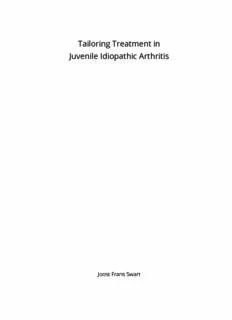
Tailoring Treatment in Juvenile Idiopathic Arthritis PDF
Preview Tailoring Treatment in Juvenile Idiopathic Arthritis
Tailoring Treatment in Juvenile Idiopathic Arthritis Joost Frans Swart 201815 Joost Swart_binnenwerk.indd 1 09-05-18 09:20 Tailoring Treatment in Juvenile Idiopathic Arthritis ISBN: 978-90-393-6989-0 Author: Joost Frans Swart Cover design: Ilse Spijker; www.studiospijker.nl Lay out: Wendy Schoneveld, www.wenziD.nl Printed by: Proefschriftmaken.nl All rights reserved. No part of this thesis may be reproduced or transmitted in any form by any means without permission in writing of the author. The copyright of articles that have been published might have been transferred to the respective journals. Publication of this thesis was kindly supported by the University Medical Center Utrecht Copyright © 2018, Joost Frans Swart, Utrecht, The Netherlands 201815 Joost Swart_binnenwerk.indd 2 09-05-18 09:20 Tailoring Treatment in Juvenile Idiopathic Arthritis Behandeling op Maat in Jeugdreuma (met een samenvatting in het Nederlands) Proefschrift ter verkrijging van de graad van doctor aan de Universiteit Utrecht op gezag van de rector magnificus, prof.dr. H.R.B.M. Kummeling, ingevolge het besluit van het college voor promoties in het openbaar te verdedigen op donderdag 28 juni 2018 des middags te 2.30 uur door Joost Frans Swart geboren op 21 april 1973 te Groningen 201815 Joost Swart_binnenwerk.indd 3 09-05-18 09:20 Promotor: Prof. dr. N.M. Wulffraat Copromotoren: Dr. S. de Roock Dr. J.J. Boelens 201815 Joost Swart_binnenwerk.indd 4 09-05-18 09:20 “It is more important to know what sort of person has a disease than to know what sort of disease a person has.” “There are, in effect, two things, to know and to believe one knows; to know is science; to believe one knows is ignorance.” Hippocrates of Kos (circa 460 – 370 BC) 201815 Joost Swart_binnenwerk.indd 5 09-05-18 09:20 TABLE OF CONTENTS CHAPTER 1 General introduction 9 PART ONE | THERAPEUTIC STRATEGIES IN JIA CHAPTER 2 Biomarkers guiding clinical strategies in JIA 21 CHAPTER 3 cJADAS in treat-to-target therapy in JIA 43 PART TWO | PHARMACOVIGILANCE IN JIA CHAPTER 4 Immunological consequences of biologicals in JIA 75 CHAPTER 5 Pharmacovigilance in JIA 105 CHAPTER 6 Risk of infections in JIA 125 CHAPTER 7 Opportunistic infections in JIA 141 PART THREE | THE BURDEN OF COMORBID CONDITIONS CHAPTER 8 Comorbidity burden in JIA 165 PART FOUR | CELLULAR THERAPIES FOR THERAPY-REFRACTORY ARTHRITIS CHAPTER 9 Haematopoietic stem cell transplantation for autoimmune 193 diseases CHAPTER 10 Mesenchymal stromal cell therapy in proteoglycan induced 223 arthritis 201815 Joost Swart_binnenwerk.indd 6 09-05-18 09:20 CHAPTER 11 Mesenchymal stromal cells for treatment of arthritis 243 CHAPTER 12 Mesenchymal stromal cell infusion in therapy refractory JIA 271 patients CHAPTER 13 General discussion 291 CHAPTER 14 Summary 325 List of Abbreviations 333 Nederlandse samenvatting 337 Dankwoord 349 Curriculum vitae 359 List of Publications 367 201815 Joost Swart_binnenwerk.indd 7 09-05-18 09:20 CHAPTER 1 201815 Joost Swart_binnenwerk.indd 8 09-05-18 09:20 General introduction 201815 Joost Swart_binnenwerk.indd 9 09-05-18 09:20 CHAPTER 1 Juvenile idiopathic arthritis (JIA) is the most common chronic rheumatic disease in children with an incidence in Europe of about 16-150/100,000/yr and an important cause of short-term and long-term disability.1 JIA is defined as arthritis with no apparent cause lasting more than 6 weeks with disease onset prior to age 16.2 JIA is a complex inflammatory disease with a multifactorial immune pathogenesis. Next to a certain genetic predisposition, environmental factors play a role leading to a chronic inflammatory response, which involves uncontrolled activation of both innate and adaptive immunity.3 The resulting autoimmune assault targets primarily, synovial tissue, leading to chronic arthritis. The classification of patients is still essentially based on the same clinical features as twenty years ago. Thus, the counting of clinically active joints is still the hallmark for the classification of JIA1 and for all clinically important decisions, e.g. the choice of treatment to start the patient on,4 when to escalate therapy or switch to another agent,4 and also when to taper or withdraw treatment. Based on 6 months of clinical symptoms and global prognostic factors, the following clinical subtypes of JIA are recognized: oligoarthritis, Rheumatoid Factor (RF)-negative polyarthritis, RF-positive polyarticular JIA, psoriatic JIA, enthesitis-related arthritis, systemic-onset JIA and undifferentiated arthritis.1 The biologic basis of these clinical subtypes is not very distinctive and indeed this classification is subject to new debate since it seems unlikely that a simple joint count would be sufficient to identify patients with different immune pathogenesis.5 Therapeutic strategies in JIA In the last 10 years the implementation of an adequate legislation fostering controlled clinical trials in children and the availability of new potent medications such as the biologicals have led to a dramatic improvement in the treatment of JIA.6 In 2011 the worldwide very much appreciated “American College of Rheumatology (ACR) recommendations on the treatment of JIA” was published.4 However, these recommendations scored very poorly in applicability (8%) because they did not clearly state the costs and resources needed in order to implement them. Criteria for assessing their impact were not provided either.7 The likely reason that these recommendations are not fully implemented is that the criteria that recommend the next treatment step are much too complicated to be literally applicable in clinical practice. Although the order in the step up treatment schemes is roughly similarly used by most pediatric rheumatologists in the developed world, it still leads to therapy-failures of at least 50% in the first 12 months of treatment resulting in frustration, pain and probably even damage to the treated tissue.8,9 In a Canadian cohort, almost one fourth of all patients did not reach inactive disease, even within 2 years.9 It is unclear what the exact decisive reasons are that physicians escalate therapy, but already the more straight forward 10 201815 Joost Swart_binnenwerk.indd 10 09-05-18 09:20
Description: